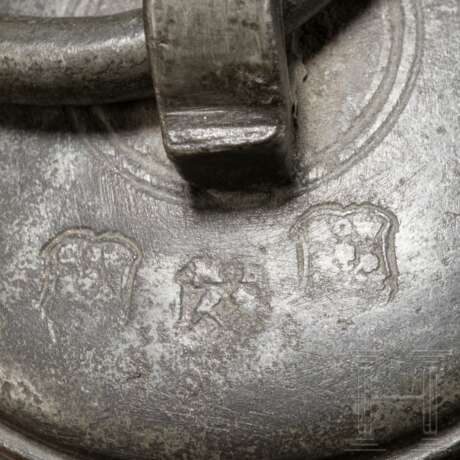ID 548371
Lot 213 | Gestempelte Barock-Schraubflasche in Serpentin, Zöblitz/Marienberg, vor 1647
Estimate value
€ 1 800
Gedrechseltes Granatserpentin und Zinnmontierung. Nonagonale Grundform mit spiralförmig gedrehter Wandung. Runde, profilierte Deckelmontierung sowie geschraubte Verschlusskappe mit Öse in Zinn gearbeitet. Diese gestempelt mit Marken für "Marienberg" und Meistermarke "C.O.W." Altersspuren. Serpentin bestoßen. Zinn berieben. Höhe ca. 20,5 cm, Durchmesser ca. 10,0 cm.
Der Zöblitzer Serpentin wurde v.a. im Barock des 17. und 18. Jhdts. für kunsthandwerkliche Objekte und Gegenstände genutzt und erlangte aufgrund seiner positiven Eigenschaften bei der Verarbeitung in ganz Europa Verbreitung. Außerdem wird dem Serpentin eine heilende Wirkung nachgesagt. Er soll Aggressivität mindern, beruhigend bei Nervosität, Stress und Anspannung wirken. Der Serpentin wurde auch als "Schutzstein gegen das Böse" angesehen. Eine ähnliche Schraubflasche befindet sich in den Beständen des KHM - Kunsthistorisches Museum Wien (Inv.-Nr. Kunstkammer, 4383, Raum XXIVa/b/c).
Literatur: Erwin Hintze, Sächsische Zinngiesser, Band I, Leipzig, 1921, S. 175.
Zustand: II -
A stamped Baroque screw-top flask in serpentinite, Zöblitz/Marienberg, prior to 1647
Turned garnet serpentinite and pewter mounting. Of nonagonal shape with a spirally fluted body. The round, contoured lid mounting and the screw-on cap with its loop all made of pewter. The pewter mounting stamped with marks for "Marienberg" and the master's mark "C.O.W." Signs of age. The serpentinite knocked. The pewter rubbed. Height circa 20.5 cm, diameter circa 10 cm.
During the Baroque era in the 17th and 18th century, Zöblitz serpentinite was used for handcrafted objects and artefacts, becoming widespread throughout Europe by virtue of its positive properties during processing. Furthermore, serpentinite is said to have healing powers. It allegedly reduces aggression and has a soothing effect on nervousness, stress and tension. Serpentinite is also regarded as a protective stone against the forces of evil. A similar screw flask can be found in the collection of the Kunsthistorisches Museum Wien (inv. no. Kunstkammer, 4383, room XXIVa/b/c).
Literature: Erwin Hintze, Sächsische Zinngiesser, Volume I, Leipzig, 1921, p. 175.
Condition: II -
| Auction house category: | Base Metals |
|---|
| Auction house category: | Base Metals |
|---|
| Address of auction |
Hermann Historica Bretonischer Ring 3 85630 Grasbrunn / München Germany | ||||||||||||||
|---|---|---|---|---|---|---|---|---|---|---|---|---|---|---|---|
| Preview |
| ||||||||||||||
| Phone | +49 (0)89 5472 649 0 | ||||||||||||||
| Fax | +49 (0)89 5472 64999 | ||||||||||||||
| Buyer Premium | 25 % | ||||||||||||||
| Conditions of purchase | Conditions of purchase | ||||||||||||||
| Business hours | Business hours
|






